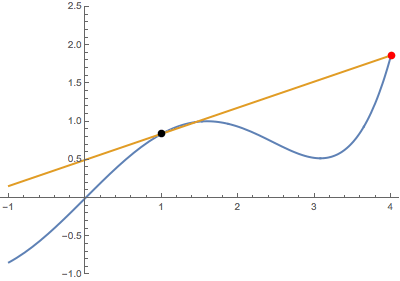Question:
Show that there is at least one straight line in the xy-plane that is simultaneously a tangent to the curve:
$$y = \frac{1}{2}x^2$$
and the curve:
$$g = \ln x,x \geq 0$$
How many such lines exist? Note that the equations of those tangents need not be determined.
The solution should use some form of calculus.
Attempted solution:
First, I use Wolfram Alpha to draw a plot just to get a very general idea of how the curves look. Of course, this is only a tiny part of the graph and the solutions could very well be outside the image.
From the question, I conclude that the two functions need not touch each other in places where the tangent lines are. This is because a given tangent line could be a tangent to the first curve at one place and a tangent to the second curve at another.
At any rate, a simultaneous tangent requires identical derivatives for the two functions.
$$y = \frac{1}{2}x^2, x \in \mathbb{R}$$
$$y' = x, x \in \mathbb{R}$$
$$g = \ln x,x \geq 0$$
$$g' = \frac{1}{x}, x \neq 0$$
Setting them equal to each other:
$$y' = g' \Rightarrow x = \frac{1}{x} \Rightarrow x^2 = 1 $$
This produces the two solutions:
$$x_1 = 1$$
$$x_2 = -1$$
I am not sure how to move on from here. Intuitively, I would perhaps see if a proposed tangent line from each of the two equations had the same y intercept, but not sure how to do that without determining the formula for the tangent (something the question says is not needed).
The expected answer is: "There are two such lines" and nothing else.
Surely, it cannot be as simple as taking the derivative, putting them equal to each other getting two x values here?
How can I wrap this up?



Best Answer
Please refer to my comment to understand why your solution is incorrect.
We have two functions, $f(x)=\frac{1}{2}x^2\implies f'(x)=x$ and $g(x)=\ln x\implies g'(x)=\frac{1}{x}$. Let the $x$-value of the point of tangency on $f(x)$ be $a$ and that of $g(x)$ be $b$.
Let us determine the general equation of a tangent for $f(x)$, then search for specific lines which only touch $g(x)$ once.
\begin{align} y-y_1&=\dfrac{dy}{dx}(x-x_1)\\ y&=a(x-a)+\frac{1}{2}a^2 \tag{Using the point $(a,f(a)$}\\ \end{align}
Now, we solve for when this tangent intersects a point, $(b,g(b))$ on $g(x)$. Note that this will include solutions where the tangent touches $g(x)$ at more than one point.
\begin{align} y&=a(x-a)+\frac{1}{2}a^2\\ \ln b&=a(b-a)+\frac{1}{2}a^2\\ \ln b&=ab-a^2+\frac{1}{2}a^2 \\ \ln b&=ab-\frac{1}{2}a^2\tag{1}\\ \end{align}
We must do the same for $g(x)$. We need to find the general equation for the tangent of $g(x)$ and find when they intersect $f(x)$. If you follow the above process, then you should end up with:
\begin{align} y-y_1&=\dfrac{dy}{dx}(x-x_1)\\ y&=\frac{1}{b}(x-b)+\ln b \tag{Using the point $(b,\ln b$)}\\ \frac{1}{2}a^2&=\frac{1}{b}(a-b)+\ln b \\ \frac{1}{2}a^2 &=\frac{a}{b}-1+\ln b \tag{2}\\ \end{align}
Solving $(1)$ and $(2)$ simultaneously for $a$ and $b$ gives two solutions: $a=0.3982,b=2.511$ and $a=1.774,b=0.5638$, given to four significant figures. Therefore the equations of the tangents are:
$$y=0.3982(x-0.3982)+0.0793$$ and
$$y=1.774(x-1.774)+0.1573$$
Here is a screenshot of Desmos to show the solution.
